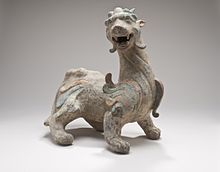Chimera (mythology)
In Greek mythology, Chimera (Χίμαιρα / Chímaira:“fabulous animal”; in Latin, Chimæra) is a hybrid monster generally considered to be the daughter of Typhon and Echidna, although for the poet Hesiod the Chimera's mother is designated by a pronoun that can refer to either Echidna or the Lernaean Hydra. The Chimera roamed the regions of Asia Minor terrorizing populations and swallowing animals, and even entire herds. It is possible that the Sphinx and the Nemean Lion were born from their union with Ortro.
Descriptions range from having the body of a goat, the tail of a serpent or dragon, and the head of a lion, to those stating that it had three heads: one lion, the other of a goat, which came out of its back, and the last of a dragon or serpent, which was born in the tail. In later descriptions, a fourth head and a pair of dragon wings were added, resulting in a monster with four heads: one of a lion, another of a goat, another of a dragon (both coming out of the back), and the last snake, which was born in the tail. It is said that it spit fire.
The Chimera was finally defeated by Bellerophon with the help of Pegasus, the winged horse, under the command of King Iobates of Lycia. There are various descriptions of its death: some say simply that Bellerophon pierced it with his spear, while others hold that he killed her by coating the tip of the spear with lead that melted when exposed to the Chimaera's fiery breath.
The Chimera of Arezzo, of Etruscan origin preserved in the Archaeological Museum of Florence, is a good example.
Roman mythology
According to the Romans, the chimera was represented with only two heads: the lion's and the goat's, which came out of the back.
Myths of the Chimera are found in the Mythological Library (book 1), Homer's Iliad (book 16), Hyginus' Fabulae 57 and 151, The Metamorphoses (Ovid's book VI 339; IX 648), and Hesiod's Theogony 319ff.
Virgil, in the Aeneid (book 5) uses Chimaera for the name of a gigantic ship of Gyas in the boat race, with possible allegorical significance in contemporary Roman politics.
Chinese mythology
Some Western specialists in Chinese art, beginning with Victor Segalen, use the word "chimera" to refer generically to hybrid winged quadrupeds of lions such as the bìxié (辟邪), tianlu and even qilin. They are often depicted with beards as well goat.
Originally, the so-called Ruìshòu (in Chinese 瑞兽) were used to protect graves as propitious animals to disperse evil spirits.
Similar creatures
A fire-breathing lioness was one of the earliest ancient Egyptian war and solar deities (representations from 3000 years before the Greek ones) and her influences are plausible. The lioness represented the goddess of war and protector of the two cultures that would unite as Ancient Egypt. Sekhmet was one of the dominant deities in Upper Egypt and Bast in Lower Egypt. As a divine mother, and above all as a protector, for Lower Egypt, Bast was strongly associated with Wadjet, the patron goddess of Lower Egypt.[citation needed]
In the Etruscan civilization, the Chimera appears in the orientalizing period that precedes the archaic Etruscan art; that is, very early. The Chimera appears in Etruscan wall paintings from the IV century BCE. C..[citation required]
In the Indus Civilization there are images of the chimera on many stamps. There are different types of chimera made up of animals from the Indian subcontinent. It is not known what the Indus called the chimera.[citation needed]
In medieval art, though the chimera of antiquity was forgotten, chimerical figures appear as embodiments of the deceptive, even satanic, forces of brute nature. Endowed with a human face and a scaly tail, as in Dante's vision of Geryon in Hell xvii.7-17, 25-27, the hybrid monsters, more like the Manticore of Pliny's Natural History (viii.90), provided iconic depictions of hypocrisy and fraud well into the 17th century, through an emblematic representation in the Iconology of Cesare Ripa.
Contenido relacionado
Dione (mythology)
Thetis (Nereid)
Stentor



